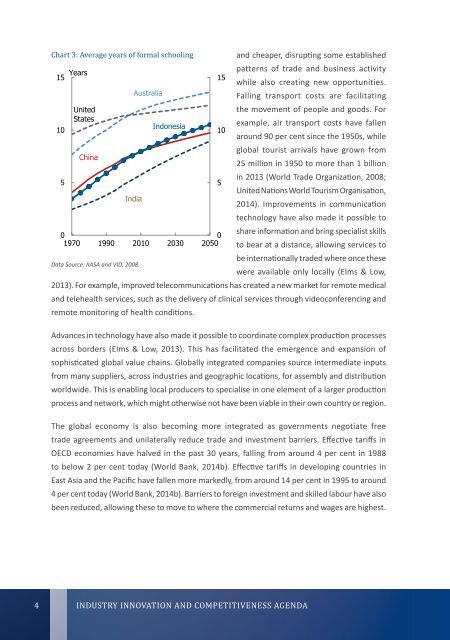Industry-Innovation-and-Competitiveness-Agenda
Industry-Innovation-and-Competitiveness-Agenda
Industry-Innovation-and-Competitiveness-Agenda
Create successful ePaper yourself
Turn your PDF publications into a flip-book with our unique Google optimized e-Paper software.
In<br />
<strong>Industry</strong> <strong>Innovation</strong> <strong>and</strong> <strong>Competitiveness</strong> <strong>Agenda</strong><br />
TPO00007<br />
Chart 3: Average years of formal schooling<br />
<strong>and</strong> cheaper, disrupting some established<br />
15<br />
Years<br />
15<br />
patterns of trade <strong>and</strong> business activity<br />
while also creating new opportunities.<br />
Australia<br />
Falling transport costs are facilitating<br />
United<br />
the movement of people <strong>and</strong> goods. For<br />
10<br />
States<br />
Indonesia<br />
example, air transport costs have fallen<br />
10<br />
around 90 per cent since the 1950s, while<br />
global tourist arrivals have grown from<br />
China<br />
25 million in 1950 to more than 1 billion<br />
5<br />
5<br />
in 2013 (World Trade Organization, 2008;<br />
United Nations World Tourism Organisation,<br />
India<br />
2014). Improvements in communication<br />
0<br />
1970 1990 2010 2030<br />
0<br />
2050<br />
technology have also made it possible to<br />
share information <strong>and</strong> bring specialist skills<br />
to bear at a distance, allowing services to<br />
be internationally traded where once these<br />
Data Source: IIASA <strong>and</strong> VID, 2008.<br />
were available only locally (Elms & Low,<br />
2013). For example, improved telecommunications has created a new market for remote medical<br />
<strong>and</strong> telehealth services, such as the delivery of clinical services through videoconferencing <strong>and</strong><br />
remote monitoring of health conditions.<br />
Co<br />
Advances in technology have also made it possible to coordinate complex production processes<br />
across borders (Elms & Low, 2013). This has facilitated the emergence <strong>and</strong> expansion of<br />
sophisticated global value chains. Globally integrated companies source intermediate inputs<br />
from many suppliers, across industries <strong>and</strong> geographic locations, for assembly <strong>and</strong> distribution<br />
worldwide. This is enabling local producers to specialise in one element of a larger production<br />
process <strong>and</strong> network, which might otherwise not have been viable in their own country or region.<br />
The global economy is also becoming more integrated as governments negotiate free<br />
trade agreements <strong>and</strong> unilaterally reduce trade <strong>and</strong> investment barriers. Effective tariffs in<br />
OECD economies have halved in the past 30 years, falling from around 4 per cent in 1988<br />
to below 2 per cent today (World Bank, 2014b). Effective tariffs in developing countries in<br />
East Asia <strong>and</strong> the Pacific have fallen more markedly, from around 14 per cent in 1995 to around<br />
4 per cent today (World Bank, 2014b). Barriers to foreign investment <strong>and</strong> skilled labour have also<br />
been reduced, allowing these to move to where the commercial returns <strong>and</strong> wages are highest.<br />
4 <strong>Industry</strong> <strong>Innovation</strong> <strong>and</strong> <strong>Competitiveness</strong> <strong>Agenda</strong>


